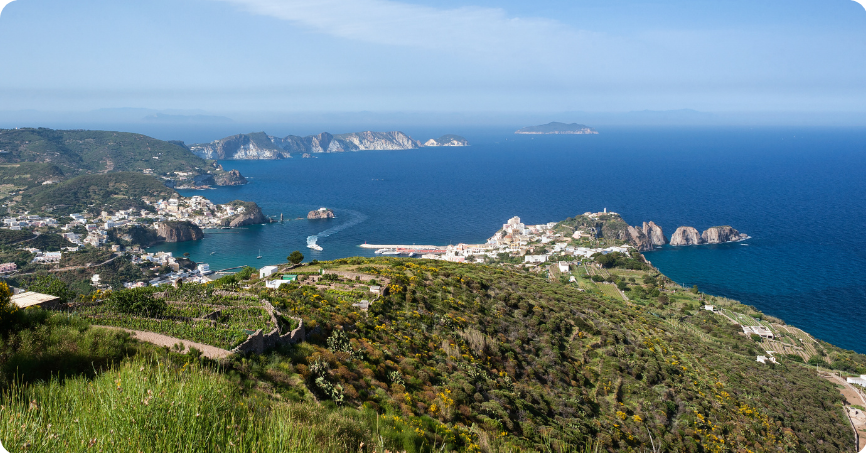Setting sail from Salerno, you can venture to the six islands that make up the Pontine Archipelago, some of the most enchanting treasures the Tyrrhenian Sea offers to seafarers. Located off the Gulf of Gaeta in northern Lazio, the volcanic islands of Santo Stefano, Ventotene, Ponza, Palmarola, Zannone, and Gavi are named after the largest of the group, Ponza. A visit to Ponza should also include its smaller, equally captivating sister islands.
Ventotene
Heading north past the tiny Santo Stefano, a circular island just 500 meters in diameter, you’ll reach Ventotene. This elongated island, covering a mere 1.9 square kilometers, is rich in historical and natural allure. Once an exile destination for daughters, nieces, and repudiated wives of Roman emperors, Ventotene preserves remarkable remnants of its ancient past. Chief among these is the Roman Harbor, one of the best-preserved ancient sites. Other highlights include the archaeological area of Villa Giulia, built on Punta Eolo by Emperor Augustus at the end of the 1st century BCE, and Roman cisterns.
From the Bourbon era, you’ll find the 18th-century Castle, now housing the Town Hall and the Archaeological Museum. After diving into history, enjoy the vibrant life of this small town or immerse yourself in the crystalline waters that lap its 3 kilometers of coastline. With hidden coves and bays, sandy and pebbled beaches, and rocky shores, Ventotene offers something for everyone—from families to couples and scuba divers exploring the stunning Marine Protected Area.
Ponza
Next, sail to Ponza, the largest and most important island in the Pontine Archipelago. With its natural beauty packed into just 7.5 square kilometers, Ponza combines wild nature and a lively atmosphere, drawing visitors who appreciate the sea, history, and vibrant social life. The island is introduced by its colorful houses and the Bourbon Port, whose current appearance was shaped by King Ferdinand IV of Bourbon. The historic center, with its ascending alleys, streets, and staircases, is full of picturesque views. Notable stops include the Church of San Silverio and Santa Domitilla, with its imposing dome and interior adorned with frescoes, mosaics, paintings, and the statue of San Silverio, the island’s patron saint celebrated on June 20.
For shopping or a sunset aperitivo, stroll along Corso Pisacane, the heart of the town overlooking the port, where you can also sample local delicacies. History lovers should visit the Roman cistern of Dragonara or explore the Case Grotta, prehistoric rock dwellings still in use.
As for the sea, many of Ponza’s most beautiful beaches are accessible only by boat or via rugged trails. While the stunning Chiaia di Luna can only be admired from afar (it’s inaccessible even to boats), other magical spots await. Highlights include Bagno Vecchio Beach and Parata Beach, the white cliffs of Capo Bianco on the western side, the Faraglioni di Lucia Rosa, the Natural Arch rock formation, the Pilate Caves, and numerous other marine caves and hidden coves perfect for exploration.
Palmarola
Among the smaller islands—Zannone, Gavi, and Palmarola—it would be a shame to miss Palmarola. Often described as a paradise on Earth for its untouched nature and incredibly transparent waters, Palmarola is known for its jagged cliffs, rocky coasts, and hidden caves. Located about 5 miles west of Ponza, the island is uninhabited, offering visitors a unique escape from the world.
Palmarola’s marine caves, including the striking Bue Marino and Cannone caves, are a must-see. The island is a haven for snorkeling and diving enthusiasts, as well as those seeking relaxation on its beaches. Its rugged and wild terrain makes it the most exotic of the archipelago. Don’t miss the Faraglioni di Mezzogiorno, a cluster of rocky islets south of the island; the “Cathedral,” a stretch of basalt cliffs carved into tall, narrow caves; Le Galere, a striking obsidian formation with black and ochre hues; and the Chapel of San Silverio. Perched atop a sea stack and reached via a long stone staircase, the chapel is said to stand on the site of San Silverio’s house, the patron saint of Ponza.

